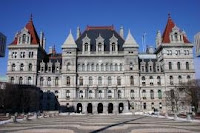 Organized in 1849 as a non-sectarian cemetery Evergreens Cemetery in Brooklyn (it actually borders Brooklyn and Queens) and covers 225 acres and is the resting place of over a half million people. This remarkable cemetery of rolling hills and gently sloping meadows features several thousand trees and flowering shrubs in a park like setting and is on the National Register of Historic Places. It is also the subject of an outstanding new book, Green Oasis in Brooklyn: The Evergreens Cemetery 1849-2008
Organized in 1849 as a non-sectarian cemetery Evergreens Cemetery in Brooklyn (it actually borders Brooklyn and Queens) and covers 225 acres and is the resting place of over a half million people. This remarkable cemetery of rolling hills and gently sloping meadows features several thousand trees and flowering shrubs in a park like setting and is on the National Register of Historic Places. It is also the subject of an outstanding new book, Green Oasis in Brooklyn: The Evergreens Cemetery 1849-2008 by noted historian John Rousmaniere.
This oversize book filled with unique and picturesque photographs by Ken Druse, traces the history of the Evergreens Cemetery beginning with the land on which the cemetery was founded, and it’s design by some of the most acclaimed architects of their time, Alexander Jackson Davis and Andrew Jackson Downing. It also shows how the forces that shaped the history of New York – population growth, immigration and growing wealth – also shaped the Evergreens. Among the monuments of fascinating characters buried there are those of Brooklyn’s Eastern District Fire Department (site of a statue memorializing a fireman who died in the Brooklyn Theatre Fire of 1876), Chinese American plots, the Triangle Shirtwaist Fire Memorial, Stranger’s mound (pauper’s graves), the graves of more then 500 entertainers, the 20th Regiment of U.S. Colored Troops plot, Yusef Hawkins (the 16-year-old African American youth who was shot to death in 1989 in Bensonhurst sparking racial tensions), Max Weber, Anthony Comstock, and literally thousands of other notable people.
Take a listen to NPR’s recent tour of The Evergreens here.
This is the rest of the post








